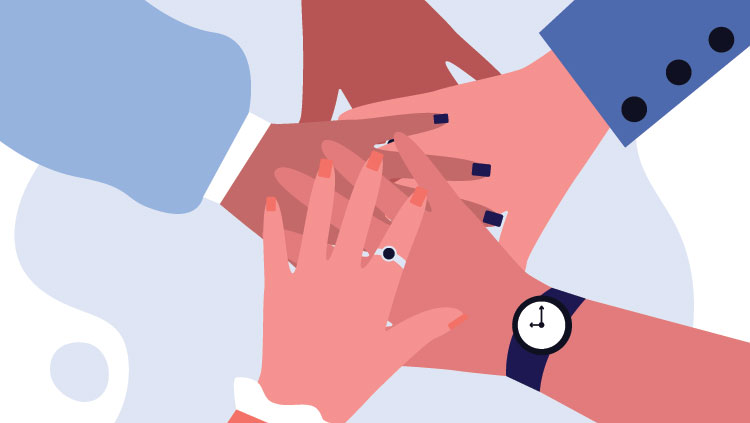Scratching the Surface of Itch Science
- Published21 Feb 2020
- Author Lindzi Wessel
- Source BrainFacts/SfN

Every time Xinzhong Dong publishes an itch study, his inbox floods with emails. The Johns Hopkins neuroscientist rarely sees such a response to his research on pain. But itch is different. Often overlooked as a minor nuisance, itch disorders can devastate. People writing Dong describe maddening irritation with no obvious source, incessant prickling that obliterates sleep for days on end, rapid weight loss from being too distracted to enjoy food, and feelings of isolation because no one quite understands.
“The emails are all very striking,” says Dong. “It’s hard for me to answer them because there is no solution yet.”
We all experience itch, but certain conditions can cause this normal sensation to go wildly awry. Allergies and chronic skin conditions commonly trigger itch. But neurological conditions, psychiatric disorders, certain drug treatments, and renal and liver failure can also result in terrible, persistent itch, even absent any kind of skin problem. Despite this wide range of itch disorders, itch has been historically understudied. To date the U.S. Food and Drug Administration has yet to approve a single drug specifically to treat itch. Now, Dong thinks we could be close to seeing that change.
“I think within five years we’re likely to have a new treatment,” says Dong, noting that as researchers continue to reveal pathways mediating itch, drug companies have started to take notice. “I’m pretty confident about that.”
A Tickle, an Itch, a Scratch
A good deal of early itch research was conducted under the assumption that itch was simply a less severe form of pain. Things that trigger itch are small — insects crawling up your arm, for example — in comparison to the larger, deeper forces of a painful cut or worse. Many researchers assumed itch and pain were conveyed by the same neural pathways, with the only difference being the strength of the stimulus triggering them. And this may be part of the explanation, but it’s far from the complete picture.
Over time, scientists realized in order to understand itch, they needed to consider it in its own right, and focus on what made it unique. For one thing, while pain prompts reflex and deliberate escape and avoidance — withdrawing your hand from the hot stove, for example — itch consistently provokes us to scratch instead. It’s a response designed to get rid of small dangers, says Anne Louise Oaklander, associate professor of neurology at Harvard Medical School. More specifically, itch probably evolved to help protect us from poisonous or disease-carrying insects, plant spines, and other creepy crawlers.
“Insects are teeny tiny, and they weigh just a few milligrams,” Oaklander says. “So, you have to have sensory physiology capable of detecting extremely subtle, tiny, little mechanical or chemical stimuli delivered onto just tiny, little areas.”
Thinking about itch in this way helped Oaklander tackle the famously harrowing case of a 39-year-old patient who suffered a severe outbreak of shingles on her forehead. It caused chronic itch so out of control, she eventually unintentionally and painlessly scratched through her skull, causing underlying abscess and long-term brain damage. Oaklander proved that the shingles attack had left so few surviving sensory neurons over her eye, that her brain interpreted the signals from these isolated, damaged, and spontaneously firing remaining sensory nerve cells as similar to an insect landing. Medications to quiet the abnormal neuronal firing along with bandaging the affected area to protect against sleep scratching — permitted her to finally stop itching and scratching and allow the hole in her head to heal.
Searching for Soothing
To solve other cases, researchers are trying to map the neural routes unique to itch, often by injecting itchy substances into humans and animals and tracking the pathways that carry the itch signal from skin to the brain.
Histamines were one of the first substances identified capable of triggering or mediating itch. They are found both within our immune systems and in some plants, bacteria, and insect venom. Scientists knew histamines could generate itch since the early 1900s when researchers applied drops of the stuff to small cuts in human skin and documented an itch response. With the development of antihistamine drugs in the 1940s to treat a broad range of allergic reactions, they became the go-to for treating itch of almost any kind. Sometimes they provided much needed relief, but more often — in an estimated two-thirds of cases — they didn’t work at all.
These failures prompted scientists to look for other options. During his postdoctoral studies in the early 2000s, Dong saw an opportunity in chloroquine. Highly effective as a malaria drug, it often causes an itch so severe that patients cannot stand to continue the medication. Dong and his colleagues studied chloroquine in mice, identifying a family of neural receptors called MRGPRs — Mas-related G protein-couple receptors — that responded to the drug. Mice missing the receptor scratched significantly less in response to chloroquine. Encouraged, Dong and his colleagues continued studying the MRGPR receptor family. They found a related receptor that responds to beta-alanine, a compound bodybuilders use to bulk-up, but which Dong says can temporarily leave users feeling as though they have “a million mosquito bites on their body.” Some MRGPR receptors respond to the contents of bile acids produced in patients with intense, chronic itch associated with liver disease. Now, Dong and his collaborators are looking for molecules to block these receptors in the hopes of helping patients desperate for treatment.
But MRGPRs are not the only promising target. Scientists have been hunting for other itch mediators in an effort to identify drug targets. A 2016 review listed more than 20 drugs under development for various forms of itch. The candidates range from compounds that sequester bile acid in order to combat liver-mediated itch to a treatment for eczema-induced itch that operates through the same receptor responsible for the burning sensation that comes with eating spicy peppers.
Though we’ll probably never be without itch disorders, the increasing interest from researchers and pharmaceutical companies means there’s good reason to be hopeful, says Harvard dermatologist Ethan Lerner who specializes in itch disorders. “A lot of drug companies are interested in this now,” Lerner says. “My view is that it’s going to be solved for many people. And it’s going to be much better for everybody.” Lerner, who shifted from patient care to research specifically because he felt there were not enough options for his patients, envisions a not-too-distant future where itch will be better, albeit imperfectly, controlled, much the way pain is today.
CONTENT PROVIDED BY
BrainFacts/SfN
Discussion Questions
1) Why did itch researchers first assume itch was another form of pain?
2) How are some researchers studying itch today?
3) What makes researchers and clinicians hopeful that advancements in itch treatments are in the near future?
References
Liu, Q., Tang, Z., Surdenikova, L., Kim, S., Patel, K. N., Kim, A., … Dong, X. (2009). Sensory neuron-specific GPCR Mrgprs are itch receptors mediating chloroquine-induced pruritus. Cell 13,9(7), 1353–1365. doi: 10.1016/j.cell.2009.11.034
Liu, Q., & Dong, X. (2015). The Role of the Mrgpr Receptor Family in Itch. In A. Cowan & G. Yosipovitch (Eds.), Pharmacology of Itch (pp. 71–88). doi: 10.1007/978-3-662-44605-8_5
Meixiong, J., Vasavda, C., Snyder, S., & Dong, X. (2019). MRGPRX4 is a G protein-coupled receptor activated by bile acids that may contribute to cholestatic pruritus. Proceedings of the National Academy of Sciences, 116, 201903316. doi: 10.1073/pnas.1903316116
Oaklander, A. L., Cohen, S. P., & Raju, S. V. Y. (2002). Intractable postherpetic itch and cutaneous deafferentation after facial shingles. PAIN, 96(1-2), 9-12. doi: 10.1016/S0304-3959(01)00400-6
Pereira, M. P., & Ständer, S. (2016). Itch Management: Treatments under Development. In Current Problems in Dermatology 50, 71–76. doi: 10.1159/000446046
Thurmond, R. L., Kazerouni K., Chaplan S. R., & Greenspan, A. J. (2014). Peripheral Neuronal Mechanism of Itch: Histamine and Itch. In Carstens, E. & Akiyama, T. (eds), Itch: Mechanisms and Treatment (Vol 10) Boca Raton, FL: CRC Press/Taylor & Francis. Available from: https://www.ncbi.nlm.nih.gov/books/NBK200934/
Also In Touch
Trending
Popular articles on BrainFacts.org


















